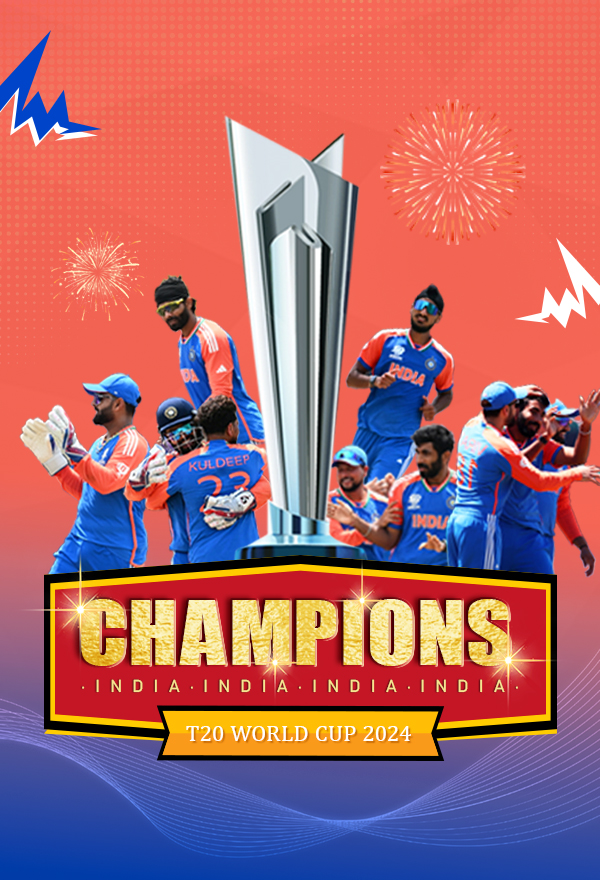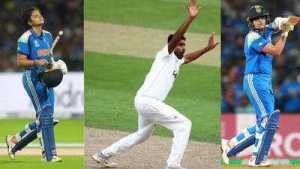
Samira Vishwas
Tezzbuzz|02-11-2025
The Indian women’s cricket team is on the cusp of history as they take on South Africa in the final of the Women’s ODI World Cup on Sunday (November 2), and the BCCI is fully prepared to honour the Harmanpreet Kaur-led side with a cash windfall if they happen to win the silverware in Navi Mumbai.
It is believed that following the “equal pay” policy advocated by former BCCI secretary and now ICC chairman Jay Shah, the top brass is mulling on rewarding the squad with same amount that was given to the Rohit Sharma-led team after winning the T20 World Cup last year.
The entire squad — players and support staff — was rewarded with a whopping Rs 125 crore for their performance in the men’s T20 World Cup, where they defeated South Africa in the final.When Indian women cricketers slept on floors
Indeed, Indian women’s cricket has come a long way, from travelling in unreserved train coaches and sleeping on dormitory floors to talks of equal pay now. Twice unlucky, in the finals of 1998 and 2017, India have fought their way into the Women’s World Cup final for the third time.
On the eve of the contest whose outcome could change the women’s game in this cricket-mad country forever, former captain, commentator and administrator Shantha Rangaswamy said Harmanpreet Kaur’s side deserves to win their first-ever title.
“From traveling in unreserved (coaches to) sleeping in dormitories on the floor, we (even) had to carry our own bedding, things like that. We had the cricket kit on the back like a backpack and (a) suitcase (in) one hand,” Rangaswamy recalled in an exclusive interaction with news agency PTI.
Also read: India vs SA, Women’s World Cup final preview: India eye historic title
“But then, we’re so happy that the current lot are getting all the facilities. They deserve it and the proof of the pudding is in the eating. The results are showing (now of) all the efforts the girls have put in, the BCCI, the state associations, all that has contributed to the success of women’s cricket.
“The foundation we laid back then, some 50 years back, is bearing fruits now,” she added.
What can change if Harmanpreet’s team lifts the Cup
Rangaswamy said the number of girls playing cricket in India would grow two or three times than the present-day count if Harmanpreet Kaur’s side lift the Cup.
“It will be a huge plus for women’s cricket in India because if you see 1983 World Cup win, Kapil’s (Dev) team changed the course of direction for men’s cricket,” she said.
“This will propel a lot of girls to take to cricket. I’m telling you, if we win this, in the next five years the number of women cricketers would have doubled or tripled in this country.”
The former skipper also praised Jay Shah for bringing about significant changes in women’s cricket, including the launch of Women’s Premier League in 2023.
“When Jay Shah was the (BCCI) secretary, he made a lot of changes. I’m sure (all that) gave a big boost to women’s cricket. I am saying this because I was on the apex to support women’s cricket. That has paid a lot of dividends,” she said.
The other Gavaskar
Another torchbearer of the women’s cricket movement in India from way back in 1973 is Nutan Gavaskar, the little-known sister of illustrious cricketer Sunil Gavaskar.
There was no money, sponsors didn’t make a beeline, and foreign tours were an ordeal, but there were women of steel who believed in the old adage that “the show must go on”, she recalled to PTI.
Also read: Harmanpreet before WC final: Know how it feels to lose, hopefully Sunday is special day
Women then played for the love of the game and for the pride of wearing the jersey with “India” inscribed on it. There were women like Nutan, who were ready to go the extra mile when the journey was arduous and no one knew if there was light at the end of the tunnel.
“The Women’s Cricket Association of India (WCAI) was formed in 1973 and it selected the national team till 2006 when BCCI finally took the women’s game under its wings. But when I look back, those were the days when there was no money but all those women fought on for the passion and love of the game,” Nutan told PTI.
Indian players celebrate after winning in the ICC Women’s World Cup semifinal ODI cricket match between India Women and Australia Women, at the DY Patil Stadium, in Navi Mumbai, on Thursday | PTI Photo
Staying with NRI families
She recalled the days of hardship, which remain a badge of honour for the WCAI, where she served as the long-standing secretary.
“When we had WCAI, we were under International Women’s Cricket Council (IWCC) and we were straightaway told that women’s cricket wasn’t a professional sport. There was no money since we were not considered professionals,” she recalled.
Arranging funds for international tours was an ordeal at times and she along with other well-intentioned pro-bono workers of Indian cricket would run from pillar to post to arrange funds.
“There was one tour of New Zealand where we didn’t have funds to arrange for hotel stay for the girls. No one would believe that our team stayed at multiple homes of NRI families, who were kind enough to act as hosts,” she recalled.
When Mandira Bedi donated her earnings
“On another occasion, we had Mandira Bedi, who shot a commercial for a famous diamond brand. The entire endorsement money that she got, she gave it to the WCAI and we arranged for air tickets for India’s tour of England,” Nutan fondly recalled.
There would be times when Air India would be magnanimous enough to sponsor the air-tickets since players were on national duty.
Also read: Beyond the boundary: Jemimah Rodrigues and the need to talk about mental health
The 1970s, ’80s and ’90s were times when it was more about willing patrons, who would come to help the women’s cricket team.
“The other day, I was so happy to see Jemimah Rodrigues’s achievement being carried on the front pages of all national newspapers. I remember those times when all we got was miniscule coverage — ‘Indian women win’ or ‘Indian women lose’.”
When Nutan spotted Jhulan
Nutan, who herself was a national-level cricketer, remembers how she recruited a lanky fast bowler called Jhulan Goswami back in the day.
“In those days, there were two recruiters — the Indian Railways and Air India. In case of Air India, it wasn’t a permanent job like the Railways and more of a contractual service. But if you had a job, you had the motivation to carry on.
“I was doing talent spotting for Air India and I am proud that I spotted Jhulan, who was a cut above everyone else at that time,” she said, the pride evident in her voice.
Shared bats and general compartment rides
Talking about the heady days of the 1970s and 1980s, Nutan would recall inter-state matches where some teams had only as many as three willows.
“I have witnessed this in national competitions. Personal kits were costly and it would be a luxury. A team would have three bats. Two openers had two willows and No. 3 had the other bat. Once an opener was out, the No. 4 would get her bat and the leg guards,” she laughed.
Also read: Faith, fire, folded hands and a flying kiss: Jemimah Rodrigues’ incredible night
There were train journeys from 36 to 48 hours in general compartments and women paid the train fare from their pockets.
“Attached toilets were a luxury. Often teams would stay in dormitories with four washrooms for 20 people and often not clean. The dal would be served from a big plastic vessel as the local association organised tournaments on a shoe-string budget.”
From no match fees to business class travel
For the likes of Diana Edulji, Shantha Rangaswamy and Subhangi Kulkarni, match fee was an alien concept.
“There were no match fees as association didn’t have any money. I know the Indian team that ended runners-up in the 2005 Women’s World Cup in South Africa got the prize money but I can’t recall if they got incentives,” Nutan added.
The WCAI was active even a decade back after BCCI had taken the women’s game under its wings.
Also read: Women’s World Cup: Jemimah’s unbeaten 127 powers India past Australia into final
“After 2005-06, I took a break from cricket administration but I came back after some years. In the initial years, BCCI’s focus was only on senior women’s cricket and there was no work at the grassroots. So WCAI arranged tournaments at U-14 and U-16 levels till a certain point. Talented players would then be absorbed by BCCI,” she said.
“Today, nothing makes me happier than when I see women’s team travelling business class, staying in five-star hotels and getting every facility which they deserve for the hard work they are putting in,” Nutan smiled.
(With agency inputs)

Smriti Mandhana Breaks Biggest Record In Women’s World Cup Final

How did Deepti Sharma become the ‘Most Valuable Player’ of Indian cricket after emerging from the streets of Agra?

IND vs SA: What is the highest total recorded in Women’s World Cup final?

Powerplay Masterclass! Smriti, Shafali Fire India Into Strong Start vs South Africa







